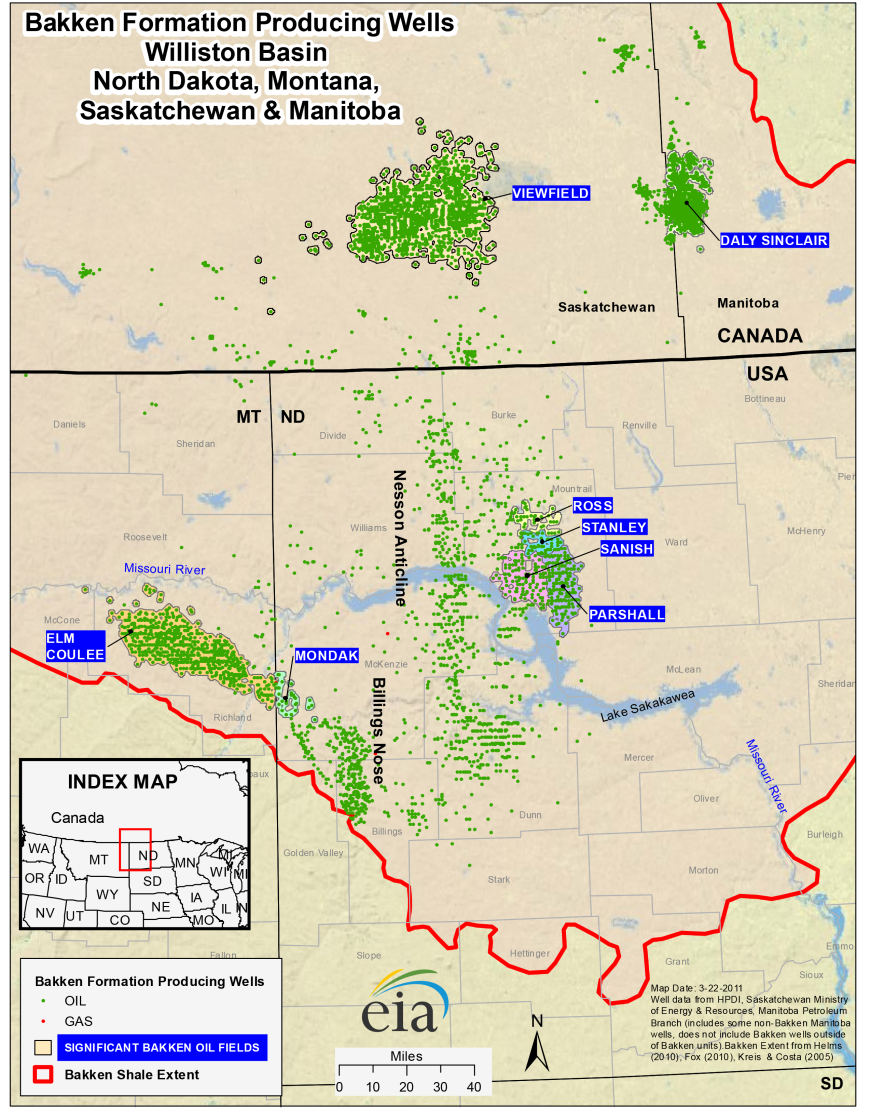History of the Bakken Shale
The Bakken Shale covers western North Dakota and northeastern Montana and also stretches into two Canadian provinces, Saskatchewan and Manitoba. At 14,700 square miles, the Bakken is the largest continuous crude oil accumulation in the United States. Some companies estimate the Bakken and underlying Three Forks formations collectively hold 24 billion barrels of potentially recoverable crude oil equivalent – 20 billion in oil and 4 billion in natural gas. These industry estimates are significantly higher than government estimates but if proven correct, the Bakken/Three Forks play would double current U.S. oil reserves.
The Bakken Shale was named after Henry Bakken, a farmer who owned land in Tioga, North Dakota, where the formation was originally discovered. The shale has been in development since 1953 when oil was discovered in Antelope Field where significant drilling occurred during the 1950s and 1960s. Over time, more resources have been recovered in the Bakken Shale as the result of evolving drilling and completion technology.
In the late 1970s and early 1980s, activity picked up in the upper Bakken. In 1987, Meridian Oil drilled its first horizontal well in the Bakken’s upper shale. Horizontal drilling occurred along the Bakken Fairway with mixed results, peaking in 1992 and ending in 2000.
In 2000, the Elm Coulee Field was discovered in eastern Montana, where the middle member of the Bakken exists. Previous drilling activities had shown that oil could accumulate inside the middle member. Since the field discovery, more than 600 horizontal wells have been drilled and more than 200 million barrels of oil have been recovered from Elm Coulee.
In 2003, the Bakken play moved east to the Nesson Anticline area in North Dakota. Unfortunately, early results did not match the Elm Coulee success due to higher fracture gradients in North Dakota. However, Continental Resources broke the code by experimenting with 9,000 foot single laterals using uncemented casing and swell packers resulting in lower drilling and completion costs and more effective stimulation of the entire lateral wellbore. The Nesson anticline remains a very active developmental area of the Bakken play today.
In 2006, EOG Resources, utilizing the same drilling and completion techniques pioneered by Continental, extended the play east of the Anticline into the Parshall area of North Dakota. EOG began completing wells capable of producing over 3,000 barrels of oil per day with estimated ultimate recoveries of 900,000 barrels of oil.
In 2008, the U.S. Geological Survey estimated the amount of recoverable oil in the Bakken Shale was 3.0 to 4.3 billion barrels. However, as of April 2013, the agency has increased its estimate to 7 billion barrels of recoverable oil.
Shale Type
The Bakken Shale was formed during the Late Devonian to Early Mississippian age nearly 400 million years ago and consists of three members: lower shale, middle dolomite and upper shale. The shales were deposited in deep anoxic water conditions. Anoxic waters are areas of sea water, fresh water or groundwater that are depleted of dissolved oxygen. The majority of the oil resides in the middle dolomite area, which is located roughly two miles below the surface.
Source: U.S. Energy Information Administration
While the drilling and completion techniques of horizontal drilling and hydraulic fracturing have unlocked this oil resource, the combination of the following characteristics make it a world class play: distribution of source rock, the thickness of the shale interval, the organic maturation and the character of trap styles. The 150 foot thick shale interval is oil wet and over-pressured causing it to fault and fracture. The shale itself sources the middle dolomite and because the impermeable layer on top of the Bakken is so tight, oil has been forced down into two additional formations, the Three Forks carbonate and the Sanish Sand.
Bakken Shale Today
Recently, analysts at Goldman Sachs wrote that the Bakken Shale formation will surprise investors and most likely exceed Wall Street’s expectations. During a trip to North Dakota, Goldman writes that the local producers and drillers were confident about expanding resources, increases in drilling and production efficiency and improving overall well performance in the coming years. The analysts anticipate production growth of 130,000 barrels of oil a day to 210,000 barrels a day through 2016. As of July 2013, there are more than 6,000 wells producing oil in the Bakken Shale formation. This dramatic increase in producing wells has placed North Dakota second behind only Texas among oil producing states.


